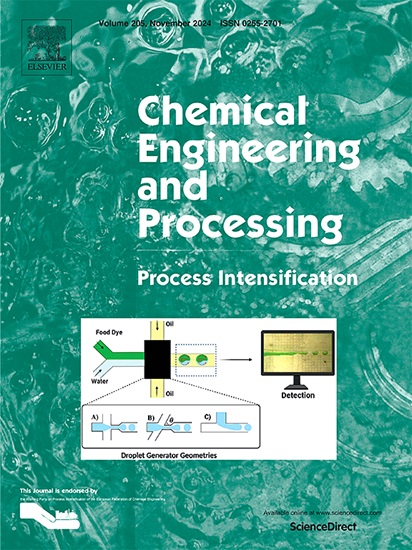Electromagnetic field-assisted process intensification for transdermal delivery of flurbiprofen: Influence on physicochemical properties, permeability, and skin accumulation
IF 3.8
3区 工程技术
Q3 ENERGY & FUELS
Chemical Engineering and Processing - Process Intensification
Pub Date : 2025-06-27
DOI:10.1016/j.cep.2025.110420
引用次数: 0
Abstract
This study investigates the impact of electromagnetic fields (EMFs) on the transdermal delivery of flurbiprofen (FLUR), a nonsteroidal anti-inflammatory drug. Flurbiprofen samples were exposed to different EMF types—oscillating (OMF), pulsating (PMF), static (SMF, both positive and negative), and rotating magnetic fields (RMF)—and their permeability through porcine skin was assessed using Franz diffusion cells. The most significant enhancement was observed with PMF (10/10), which increased the steady-state flux (JSS) from 21.78 µg/cm²·h (control) to 233.89 µg/cm²·h. RMF at 50 Hz also markedly improved permeability, yielding a JSS of 103.61 µg/cm²·h. Physicochemical analyses (FTIR, XRD, DSC, TG) revealed no degradation or chemical changes, though minor alterations in crystallinity and thermal parameters were noted. Changes in solubility and lipophilicity were dependent on EMF type, with RMF 50 Hz showing the highest aqueous solubility (43.14 mg/L). Overall, the findings support the use of EMFs, particularly RMF and PMF, as effective, non-invasive enhancers for transdermal drug delivery of FLUR, offering a pathway to improved bioavailability and reduced systemic side effects.

电磁场辅助的氟比洛芬透皮给药过程强化:对理化性质、渗透性和皮肤蓄积的影响
本研究探讨了电磁场(emf)对氟比洛芬(FLUR),一种非甾体抗炎药经皮给药的影响。氟比洛芬样品暴露于不同的电磁场类型——振荡(OMF)、脉动(PMF)、静态(SMF,正负)和旋转磁场(RMF)中,并使用Franz扩散池评估它们在猪皮肤中的渗透性。PMF(10/10)的增强效果最为显著,使稳态通量(JSS)从21.78µg/cm²·h(对照组)增加到233.89µg/cm²·h。50 Hz的RMF也显著提高了渗透率,JSS为103.61µg/cm²·h。理化分析(FTIR, XRD, DSC, TG)显示没有降解或化学变化,但结晶度和热参数有轻微变化。溶解度和亲脂性的变化依赖于EMF类型,RMF 50 Hz显示最高的水溶性(43.14 mg/L)。总的来说,研究结果支持使用emf,特别是RMF和PMF,作为FLUR经皮给药的有效、非侵入性增强剂,提供了提高生物利用度和减少全身副作用的途径。
本文章由计算机程序翻译,如有差异,请以英文原文为准。
求助全文
约1分钟内获得全文
求助全文
来源期刊
CiteScore
7.80
自引率
9.30%
发文量
408
审稿时长
49 days
期刊介绍:
Chemical Engineering and Processing: Process Intensification is intended for practicing researchers in industry and academia, working in the field of Process Engineering and related to the subject of Process Intensification.Articles published in the Journal demonstrate how novel discoveries, developments and theories in the field of Process Engineering and in particular Process Intensification may be used for analysis and design of innovative equipment and processing methods with substantially improved sustainability, efficiency and environmental performance.

 求助内容:
求助内容: 应助结果提醒方式:
应助结果提醒方式:


